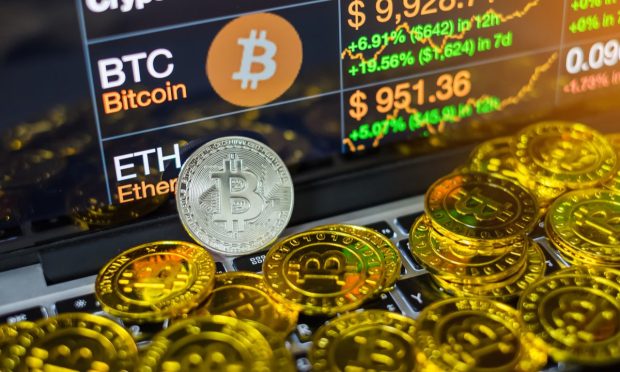Bitcoin’s Highly Touted Decoupling vs. Fed’s Rate Hike Reality

Federal Reserve Chairman Jerome Powell did exactly what he was expected to do Wednesday (Jan. 26), hinting even more strongly that interest rate hikes are coming.
The stock market did exactly what it was supposed to do, tank immediately after the 2 p.m. announcement.
And crypto? Well, it did more or less what it was supposed to do, which was head in the same direction as the broader stock market, and for the same reasons: As interest rates climb, investors tend to pull money out of the riskier, more speculative investments and put it into things like bonds.
And given that bitcoin is about as speculative as it gets — unlike corporate equities, there’s nothing at all backing it — BTC did what it was supposed to do, which was tank. It’s down almost 5%.
See also: Small Investors’ Lottery Mentality Tested as Crypto Crashes
Except that that’s not what was supposed to happen, according to last fall’s wisdom that bitcoin was parting ways with stocks. Look back at October’s crypto industry headlines and you’ll see the word “decoupling” a whole lot. Shoot back a few more months and you’ll see “digital gold.”
Just like them
But that’s based on today’s high price. Over the past 24 hours, Bitcoin is down … nothing. At this writing it’s up 0.69% on the day. (By the time this article was finished, BTC was down a very satisfyingly symmetrical 0.69%. Which affects the main point not at all.)
Most of the day, it was well ahead. In fact, BTC spiked at 2:09 p.m., coming within sniffing distance of $39,000 right about the time Powell was at the microphone. In after-hours trading, it hovered just below $36,000.
So, what’s happening? One answer is that the Fed’s rate hike and asset purchase cuts were priced in. The 10 largest cryptocurrencies by market capitalization were down 12% to 33% on the week. But with one exception — Terra’s LUNA coin — they’re down about 4% on the day.
That fits in with the broader market — the S&P and Dow closed down slightly and the Nasdaq was up a hair.
But more than anything, it reinforced the growing belief that the narrative of Bitcoin and crypto generally that became popular last fall — that they were decoupling from stocks — was wishful thinking. Or maybe just hot air, a substance the cryptocurrency market has no shortage of.
Two factors
There were two main arguments made in favor of decoupling, starting with:
- Bitcoin is an inflation hedge.
The pitch was that bitcoin was becoming its own third category of cryptocurrency, a “store of value” — an asset that retains its value in the face of inflation. That would make it a new digital gold. Because there is a hard maximum of 21 million bitcoins, it is a non-inflationary asset, the argument goes. And because it’s blockchain-based, governments cannot manipulate it.
With inflation surging to 7% in December — a 40-plus year high — and forcing the Fed’s hand when it comes to rate hikes (not that it needed much forcing), that was put to the test.
Does bitcoin maintain its value? In the face of the Venezuelan bolivar, yes. As an asset that made two full round trips from the $30,000s to the $60,000s in 2021 and is already back in the $30,000s as January closes out? Not so much.
- Institutional money is coming.
Well, yeah. A fair number of big investors jumped in, forcing the hand in firms ranging from venture capital firms to Goldman Sachs to JPMorgan Chase in regards to offering wealthy clients crypto investments.
A couple of problems with that. First, just because it’s coming doesn’t mean it’ll continue to come. Second, big investors often know how to, and are willing to, cash out at the top.
But also, a lot of small investors are coming. Estimates earlier in the year of the 12% to 13% of Americans own or have owned crypto have recently crept up to 16% in some studies. And a fair number operate on the FOMO/FUD principle — buy high for fear of missing out, sell low due to fear, uncertainty and doubt. Others simply have to tap highly liquid crypto investments when stock investments pinch.
On the Other Hand
Another explanation for decoupling is the Q4 Pump.
Historically, bitcoin has seen a big year-end price spike. There are a bunch of reasons proffered, but it comes down to “it happened before, it’ll happen again.” So people buy in advance of that particular market feature unrelated to economic outlooks and other factors that still affect stocks.
And, it did happen. Bitcoin ended September around $48,000. It hit a new all-time high of $68,789 on Nov. 10 — right smack in the middle of Q4. Then it plummeted.
One can argue — and this one would — that’s not decoupling. That’s experienced traders betting on a cyclical event that can become a self-fulfilling prophecy dragging the market temporarily out of whack.
See also: Bitcoin’s Slide Casts Doubt on Its Usefulness for Payments
